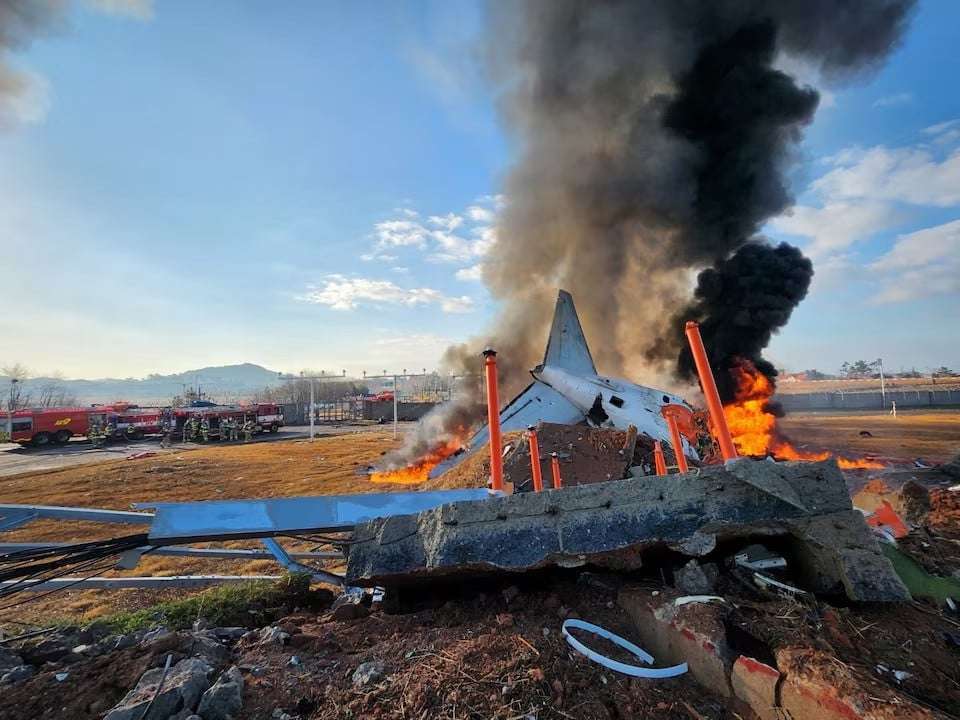H1: Jeju Air Flight Tragedy: A Catastrophic Crash in South Korea
On Sunday morning, a devastating plane crash at Muan International Airport in South Korea resulted in the loss of at least 167 lives. The Jeju Air flight, which was en route from Bangkok, Thailand, to South Korea, crashed during its attempt to land, causing massive destruction and loss of life. The crash, involving a Boeing 737-800, has raised serious questions about aviation safety and has left the global aviation community in shock.
H2: The Crash Details: What Happened at Muan International Airport?
The flight, operated by Jeju Air, carried 181 people, including 175 passengers and six crew members. It was around 9:03 AM local time (00:03 GMT) when the disaster struck. The Boeing 737-800, a well-known and widely used aircraft, encountered a malfunction during its landing attempt at Muan International Airport. The plane collided with a barrier shortly after attempting to land and burst into flames.
H3: Early Reports on the Crash
According to the South Korea’s National Fire Agency, only two survivors were found amidst the wreckage. These survivors, a crew member and a passenger, were both flight attendants who miraculously managed to escape the inferno. The rest of the passengers and crew members on board perished in the fire. The crash involved 79 women, 77 men, and 11 individuals whose genders were not immediately identified.
H2: Theories Behind the Crash: Bird Strike and Weather Conditions
H3: Bird Strike as a Potential Cause
Initial reports from authorities suggest that a bird strike, combined with adverse weather conditions, might have played a role in the crash. The Ministry of Land issued a warning about a bird strike just minutes before the plane’s landing attempt. Bird strikes remain a significant hazard to aviation, with the potential to cause catastrophic engine failure if birds are ingested into the engines.
H3: Weather Complications in the Area
Aside from the bird strike, weather conditions in the region were less than ideal, which may have compounded the issue. The plane’s malfunctioning landing gear, combined with the impact of a bird strike and poor weather conditions, may have resulted in the crash. Video footage from the scene revealed the plane skidding on its belly across the runway, emitting thick smoke from its engines before slamming into a wall and erupting in flames.
H2: Emergency Response and Recovery Efforts
H3: Swift Government and Emergency Actions
The South Korean government has taken swift action to manage the aftermath of this tragic incident. Acting President Choi Sang-mok convened an emergency meeting to coordinate rescue and recovery efforts. “No words of consolation would suffice for the bereaved families who have suffered this tragedy,” said Choi in a heartfelt statement. He emphasized that the government is dedicating all available resources to the recovery process.
Prime Minister Shehbaz Sharif of Pakistan also expressed his condolences, offering prayers and support to the grieving families of the victims.
H3: Difficulties in Identifying the Deceased
The scale of the destruction has made it nearly impossible to identify all the victims at the crash site. The plane was nearly completely destroyed by the fire, and the identification of the victims is a challenging and lengthy process. Emergency services are working diligently to manage the recovery operations and provide assistance to the affected families.
H2: The Aviation Safety Record of Jeju Air and South Korea
H3: Jeju Air’s History and Safety Record
This tragedy marks the first fatal accident in the history of Jeju Air, a popular low-cost carrier in South Korea. Established in 2005, the airline has had a relatively good safety record, with only minor incidents in the past. This marks a major shift for the airline, as it has now experienced its first-ever fatal crash. However, the airline has cooperated fully with the ongoing investigation and has expressed deep condolences to the families of the victims.
H3: South Korea’s Aviation Industry: A History of Safety
South Korea’s aviation industry has long been known for its solid safety record. Compared to other countries, South Korea’s aviation industry has seen relatively few fatal accidents, though bird strikes have been a consistent global concern. The Jeju Air crash serves as a grim reminder of how quickly things can go wrong in aviation, even in regions with strong safety regulations and systems.
H2: Ongoing Investigation: What Caused the Crash?
H3: The Role of Boeing in the Investigation
Jeju Air has confirmed its full cooperation with aviation authorities and experts in the investigation process. Boeing, the manufacturer of the 737-800, has also pledged to assist with the investigation. Authorities are investigating the bird strike and weather conditions as the primary causes of the crash, but all possibilities are being explored.
H3: A Joint Investigation into the Cause
A joint investigation by aviation experts, local authorities, and representatives from Jeju Air and Boeing is underway. The investigation will aim to determine the exact cause of the crash and how such a tragedy could have been avoided. As of now, authorities have not ruled out any potential causes, and a full investigation is expected to take several weeks.
H2: The Aviation Industry in 2024: A Year of Tragedy
H3: Other Major Aviation Disasters of 2024
The Jeju Air crash is one of several fatal aviation accidents that have marred the year 2024. Earlier in the year, an ATR-72 aircraft operated by Voepass Airlines crashed in Brazil, killing 62 people. In Kazakhstan, an Azerbaijan Airlines flight crashed, resulting in numerous fatalities. Additionally, several military aircraft crashes also occurred, including one involving a Russian military plane.
H3: Rising Concerns About Aviation Safety
The frequency of fatal crashes in 2024 has raised concerns among aviation professionals and passengers alike. While aviation safety has improved significantly over the past few decades, incidents like the Jeju Air crash highlight that aviation remains a high-risk industry. Experts continue to stress the need for improved safety protocols and technologies to prevent further accidents.
H2: Airline and Government Responses to the Tragedy
H3: Jeju Air’s Apology and Commitment to Support Families
In response to the tragedy, Jeju Air has issued a public apology, expressing its deep sorrow for the loss of life. The airline has promised to provide assistance to the victims’ families, including financial support and counseling services. Boeing has also offered its help and is working with the airline and investigators to understand the cause of the crash.
H3: Government and International Support
The South Korean government, along with international organizations, is providing support to the families affected by the crash. Emergency teams have been dispatched to assist with recovery operations, and psychological support is being offered to those impacted by the tragedy.
H2: FAQs
1. What caused the Jeju Air crash?
The exact cause is still under investigation, but initial reports suggest that a bird strike combined with poor weather conditions may have played a role in the crash.
2. How many people survived the crash?
Only two people survived the crash, both of whom were flight attendants.
3. What is the history of Jeju Air’s safety record?
Jeju Air, established in 2005, had a solid safety record until this tragic incident, making this its first fatal crash.
4. What is being done to support the victims’ families?
Jeju Air has promised to provide financial and emotional support to the victims’ families. The South Korean government is also offering resources and assistance.
5. Has the investigation determined the cause of the crash?
The investigation is still ongoing, but authorities are focusing on the possibility of a bird strike and weather conditions as contributing factors.



